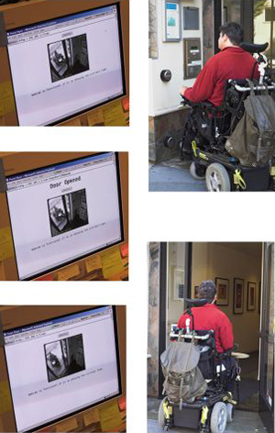The Computer Technologies Program took possession of its new home at 2002 Addison St., Suite 201 in 2003. Because the building was constructed shortly before then, it necessarily complied with architectural standards as set down by Title III of the Americans with Disabilities Act. As most disabled people know, the standards are rather general and often do not adequately serve the needs of a diverse population of persons with disabilities, such as the student body at CTP. Since moving in, CTP staff have been working to augment the architect’s work with more extensive accessibility features to our physical plant.
CTP’s offices are necessarily secure. Not only do we possess a lot of valuable computer equipment, but the building itself is also theoretically secure for the benefit of the three stories of residential apartments above our classrooms. To enter 2002 Addison, a visitor must either punch in an access code on a keypad mounted right outside the street door, or use the same keypad to call the resident they are visiting. Such a system creates an access issue for many persons with disabilities. If the visitor is blind, they will find no Braille on the keypad, and what’s more, the automatical door can swing out and hit them. Most people using wheelchairs will find the keypad is mounted so close to the door that maneuvering their wheelchairs or scooters close enough to the keypad without hitting the door frame is well-nigh impossible. And visitors who are deaf will not be able to hear the prerecorded voice intoning “access granted,” which is the signal for those who can, to pull the door open and enter the building.
Working extensively with volunteer Scott Luebking and Jon Eccleston of Open Sesame Remote-controlled Door Opening Systems, we devised a system involving a pair of large metal push-pads, mounted on the corner of the entrance wall nearest the sidewalk. When a visitor pushes one of these pads (one at wheelchair foot plate height, and one at waist height for a person who is standing), a doorbell sounds within CTP’s offices. Any staff member can open a web page on their computer, see who the visitor is, and press a button on the web page which automatically causes the street door to swing open. Because the push pads are set on a corner of the building near the sidewalk, there is no danger that the visitor will be accidentally hit by the opening door, and, we believe, the corner location will be easier for a visitor who is blind to locate, since it is right at the sidewalk. There are also large raised letters on the upper push-pad, identifying the pad as for “CTP,” and Ayaka Isono of ERC-partner the Lighthouse for the Blind and Visually Impaired donated a Braille strip for the upper pad, reading “Computer Technologies Program.”
 Computer Technologies Program The Bridge to a Career
Computer Technologies Program The Bridge to a Career
